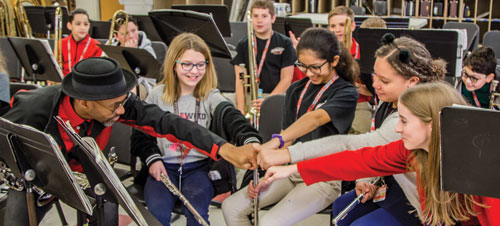Mickey Smith, Jr., the 2020 GRAMMY Music Educator of the Year, is the head band director at Maplewood Middle School in Sulphur, Louisiana. Under his direction the band has grown over 500% and now encompasses nearly 50% of the total school population. He has a remarkable gift for reaching and teaching students and an irrepressible joy for music making, seeing music and education as opportunities for people to discover the best in themselves and in others.
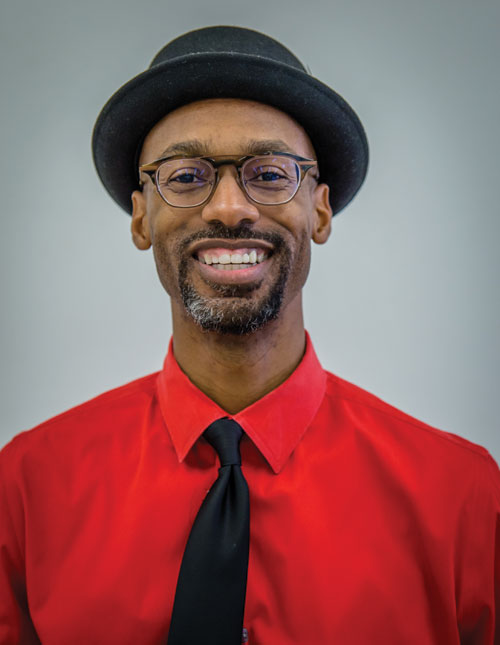
How do you communicate the importance of music?
Music is important because it’s music. The increase in testing scores is a by-product, but music is important because it’s an essential element to this human experience. It is important because of what it means to us and how it shapes how we see and experience life. This is why music permeates so many aspects of life. I teach a fine arts survey class, and the way I open the class is to play the throne room scene from the end of Star Wars. They have won the battle and walk down the aisle to such epic music. Even the part where Chewbacca screams is so fitting with the music. Then, I play a second version of the same scene without music. When you take music away, it becomes an long walk punctuated by an awkward Chewbacca noise. It makes the students giggle every time.
I tell students that art decorates space, but music decorates time. When you hear a song, it takes you back to a moment, and when we think about that moment, we think about an experience. That’s why a certain type of music can put you in a funk while a different type takes you to a beautiful place.
I don’t have a formula yet to quantify our humanity when exposed to music. It is difficult to explain that beyond saying it is something that is felt. All I can do is share personal testaments and stories that I believe anybody with a reasonable set of eyes and ears and half a heart can understand.
What stories do you share to inspire your beginners?
At the beginning of the year I explain to my students that my first sounds on the saxophone were amazing, or as I like to say, amazingly terrible. They were so bad that I was encouraged by my mom to keep on going, not simply with my practice, but also with the location of my practice. I was encouraged to take the horrendous sounds of my beginning band exploits outside, down the driveway, and ultimately across the street and into the forest. That forest became my practice room for the next year or so. In that isolation I achieved an elevation of my craft, by which I mean the practice and the process I participated in led to the sounds I can share with my students and audiences today. I conclude my story telling students that I now realize that my mom never said to stop, she simply said to keep on going. I also share with them that “keep on going” is the message we will share with one another throughout the year. I tell them that there will be many times this year that they will not always understand what is going on, but they should trust that it is going somewhere. To reach the promise, they must trust the process presented by me in the classroom. Thus. “keep on going” becomes our class mantra for the year.
My process and promise were made more evident when my parents finally welcomed me back into the house to practice for them. It was at that point that I knew anything and everything was possible. When my parents opened up that door and invited me in to play for them, I knew I had improved. During this story, I explain to my students how much that opened door meant to me as a little boy who struggled with self-esteem. The door that my parents opened to me said that I was loved, valued, and wanted. The story of “Keep On Going” is one of persistence, patience, and perseverance that becomes a foundation for the success of our band, our students, as well as in their future life endeavors.
For my students, this one tiny whiff of transparency and vulnerability that I share at the start of the year communicates that I am neither aloof, nor untouchable. It expresses to them that Mr. Smith is simply a caring adult trying to navigate the school year and share some wisdom with them along the way. It also makes me more human in their eyes – human enough that they then feel as though they can share their concerns, motivations, and dreams.
I often hear music educators lament that students are reluctant to participate in class for fear of being labeled as bad sounding. A phrase I like to share with students is that I am humanity on display, meaning that I have experienced failure and disappointment as I learned this craft called music. This fosters trust, which leads to a relationship, which gives you the opportunity to influence students. Influence is the door for instruction.
Telling this story is the start of a presentation I call First Days Lasting Ways that creates lasting ways of success by outlining classroom culture, growth mindset, guidelines, procedures, and strategies in a way that students can understand and appreciate. It consists of team-building exercises and more of my stories, but everything is strategically planned and set up in a PowerPoint presentation developed from my past experiences, books I have read, and things I have been told by students. That last bit is especially important. A 2000 movie, What Women Want, was the story of a advertising executive who, after an electrical accident, gained the ability to know what women were thinking. I have figured out what kids want through a more direct approach: asking them.
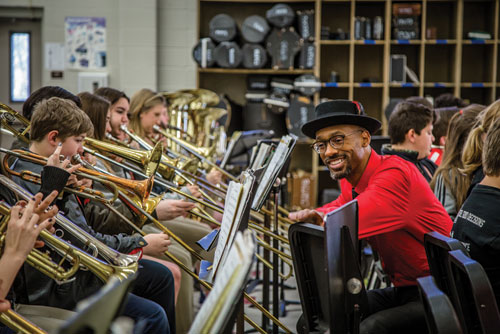
The first thing students want to know is who this person at the front of the room is. They don’t use the word teacher; they just want to know who we are. They want to know what the expectations are, what they’re going to teach, and how it will be graded. They want to know they are in the right classroom. It is easy to forget these kids are ten years old. It might be their first time in middle school. They’ve never opened up a locker before. They’ve never had to change classes. The school is big. The eighth graders are huge. They’re scared to death. On top of that, they’re at that age when they think everyone is looking at them, so anything that you can do to mitigate that stress that comes with sticking out or being wrong is huge. They care about that more than music.
I use this as a springboard to explain how music shaped my life, how I was the first in my family to go to college, and that I grew up in a forgotten community but am now able to stand on phenomenal stages, not because there is anything special in me, but because music was so special to me, and it provided me a platform for me to discover who I am. I finish by adding that if they believe and trust, music can be the same thing for them. When you tell a student, “Your story won’t be my story, but your story may be greater,” it opens up the possibilities of what this class can be. Every day that students come to class, I’m not giving them something to do, I’m giving them something they can be. I want the children to see themselves in my experience. I show them the possibilities of what they could become through music. As adults, we understand what the end game can be, but we rarely take the time to explain it to our beginners.
The PowerPoint presentation takes two weeks to get through because there is only so much that ten-year-olds can process in a day. Too much information will leave them frustrated. This is why Sesame Street only covers one letter and one number in each episode. If children watch Sesame Street diligently enough, they will be ready for pre-kindergarten, but the show doesn’t teach everything in one day.
We start with things that might not be musical in and of themselves but are essential for music, such as toe tapping and watching the conductor. One day I spend ten minutes talking about posture, intentionally making it as boring as possible. At the end, I remark, “That was a lot of information about posture, but you don’t have time to hear that again,” to which students quickly agree. At this point, I break down posture again, only taking a minute or so, but still too long. When I ask students who can say that back, no one can because I used too many words. I then start beatboxing, getting students to clap to the beat while I say, “First you got to sit tall, let your shoulders fall. Make them meet in the back, and put your feet down flat.” I repeat it in rhythm a couple times, then nod at students, who instinctively realize it is their turn to say the rhyme. I point out that we just said in ten seconds everything that originally took me ten minutes to say, but then I say it is still too much time to spend on posture. I explain that in this class our cues will be either non-verbal or concise verbal cues, and for posture, the cue is the word s-e-t. I spell it rather than say it because I want to be very intentional that when I say something, that’s what we do. I tell students, “When I say the word s-e-t, I need you to sit tall, shoulders fall, meet in the back, feet flat. All right now, can you say that quietly to yourself in five seconds?” When you tell a kid to do something quickly, they get excited. “Oh, of course I can say it fast.” Then I’ll say, “Who can say it in their head in two seconds.” Oh, man, all the hands come up. I’m giving them these challenges, but I’m also giving them an opportunity to win. I’ve taught this element of musicianship in such a way that students can’t lose.
Kids like to win, and I use this to teach teamwork. If one student gets an A in math and another gets an F in math, that first student is going home happy. Someone else’s F doesn’t affect her. In band, however, if one student has an A performance, but another is performing at a F level, it makes the A student sound bad, no matter how much she practices. I want students to develop the mindset that it’s not enough for you to win. We’ve all got to win. I punctuate this by proclaiming that every day in this class is wins-day.
First Days Lasting Ways lasts so long because we focus on one thing every day, making games out of these basic skills, and then, like Legos, we stack them up until we get to that predesignated end of us being able to model all these different things simultaneously before we hand them the horn.
How do show students that they are progressing during those first days?
Our class has a First Days Lasting Ways mascot named Tatiana the Turtle, which we move from shelf to shelf around the room according to the students’ participation, progress, and overall success. Tatiana’s movement is predicated on their ability to exact any one of the basic skills we are learning. On a day we are working on posture, at the end of the day I’ll give them a thumbs up and praise them for their posture. They come back the next day, anticipating seeing Tatiana move. If they truly did well, then Tatiana might move five feet. If it is a day where students weren’t getting the concept or behaving well, Tatiana might only move six inches. This gives me an opportunity to say, “Tatiana didn’t really move much today. Can we get Tatiana moving?” This gets students excited to work hard and see her move farther.
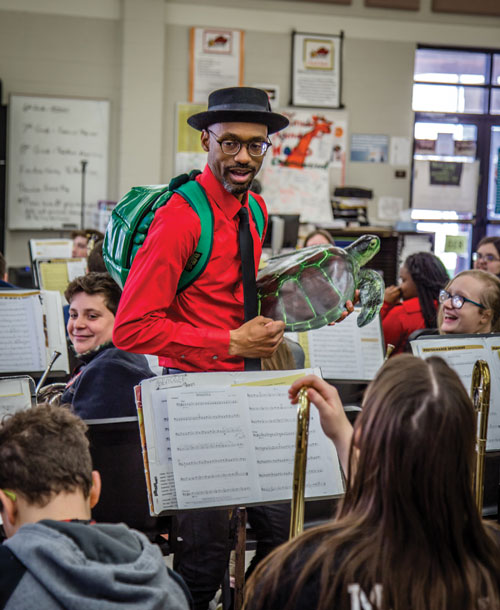
Tatiana is simultaneously a visual representation that things start slowly and a way for students to see that they are getting better, even if we haven’t touched the instruments yet. It takes about two weeks for her to make her way around the room before she disappears. On the day this happens I congratulate the students, telling that they are no longer my band babies and are ready to take their music to the next level. Tatiana comes to show students their progress, but now they are at the point that they can hear themselves improve.
I recently had a 20-year-old former student stop by to gift me with a blinged out turtle she found on vacation. She said it could be Tatiana 2.0 in case the original ever retired. She was a beginner ten years ago, but she still thinks of Tatiana as special. Little things like this stuffed turtle are the drivers in getting young children to learn. It is a way to show them that they can win – and that they are winning.
Besides showing students that you care for them, what are some other traits you have seen in successful teachers?
I often ask other educators, “Hey, what’s your process? What are your thoughts?” I see some common threads between all those educators that we deem successful, and one thing that I find is that the educators I feel exhibit those successful traits – the ability to elevate their craft and their program and keep that love for it – are those folks who see teaching as an extension of performance.
In college, you had a principal instrument, took lessons, attended masterclasses, and performed in both large and chamber ensembles. These exist to make you a better performer. We understand the value of practicing, and we understand that it is an endless process – that with every level, there is another level to be attained.
Teaching is just like playing a musical instrument: everyone has a unique sound. The components of that sound are having passion and heart, knowing who you are, having knowledge and competence in the field, being an effective communicator, and physical energy. This is a sound that communicates “I love you the way you are, but I love you enough not to leave you the way you are.” It is in our best interest to develop that sound, just as we would on our instruments. We best do this by observing other teachers. Just as we listen to music for enjoyment but also listen critically, we should also observe other teachers to emulate their best practices.
On top of this, practice teaching. No one blinks at the idea of practicing their instrument, and educators know myriad ways to practice, one of which is making audio and video recordings. If anything, many educators are too uncomfortable with the sound of their own voices or too afraid of what they might see to want to do this. However, this is where the growth comes from. Improvement happens when you get out of your comfort zone.
I even script what I’m going to say at the start of class. This is no different than a football coach scripting the first few plays. In football, the first few plays are almost always planned. Teams establish their identity on the field and then adjust as needed. It is easy to go into a situation ready to adjust right off the bat, but no great performer would do that. Any great performance you see always has a show opener. I think that teaching is much the same way. That’s why each class period I start with the Code of Cooperation:
Follow Directions
Raise Your Hand to Speak
Stay In Your Seat
Be Prepared
Respect Property of Others
Treat Others With Respect
Gum, Candy, Food, or Drink Are Not Allowed
We start every day with this because the kids that I’m reaching – notice I didn’t say teaching – need some level of consistency, and my class might be the only consistent thing they have in their day. I find that many teachers make the mistake of expecting students to come to class already ready to participate and equipped to learn, but there are many reasons a student’s focus could be elsewhere. Saying the Code of Cooperation religiously not only creates a positive, purpose-driven tenor to the class, but also each day it points us in the direction of success. Once I provide those initial moments of consistency, the trust manifests again, and that sets the stage for me to be the performer that I need to be. It is a behavior management tool as well. When they fail to follow directions, instead of me admonishing them directly, personally, and possibly in a hostile manner I simply give them the signal that cues them to say “follow directions” collectively. This has a calming, redirective effect, and we can get back to what we were doing together.
How important is emotion in teaching music?
I used to think that if you wanted to be rational and think well, you had to suppress emotions as well as your willingness to show and express them. This led to a mindset that teaching was a matter of me knowing a lot of things and consisted of me downloading knowledge into my students’ brains, devoid of any passion, but the truth is that people have been given emotions for a reason. Emotions assign value to things. If you don’t know what you want, you can’t make good decisions.
Emotions can also tell us what to pay attention to, care about, and remember. Personally and professionally I have found that it is more difficult to work through hardship if your emotions are not engaged. Our students are no different. As I speak to educators and students across this country I am reminded that in the classroom and life information is often plentiful, but motivation is scarce.
The late Rita F. Pierson made it her mission to teach the world that kids don’t care how much you know until they know how much you care. I am reminded that children learn better from people who love, and that love in this context means an ability to will the good of another, and offer active care for the whole person. I make a point to take time every day, every class period, to tell my students that I love them and I love being there for them at the start of class. This is not mere lip service; I also provide them consistency and intentionality, while communicating their importance to me at that moment. They must know that they are the most important thing in my world at that time and as a result, I find that I become the most important thing to them as well. What I’m imparting to them, in turn, becomes of great value to them.
When you think about your favorite teacher, your first thoughts are never about what that person taught you. They are about how that person made you feel. Once you feel a certain way about someone, then you start to trust them. There are kids in my class who have come from difficult situations, and they do not trust people easily. That lack of trust often manifests as misbehavior or defiance. This is almost never personal; I don’t think children wake up in the morning thinking, “Let me see how I can make Mr. Johnson’s life terrible today.” Many times the kids who need love the most show it in peculiar ways, sometimes through their behavior.
When there is trust and that sense of connection and belonging, typically people want to be better for that person who believes in them. I think that at the end of the day, children are natural people pleasers, but they have to trust you, believe in what you do, and see you as a sound adult. I believe that every child is one sound adult away from discovering their sound of success – whether that is in music or something else.
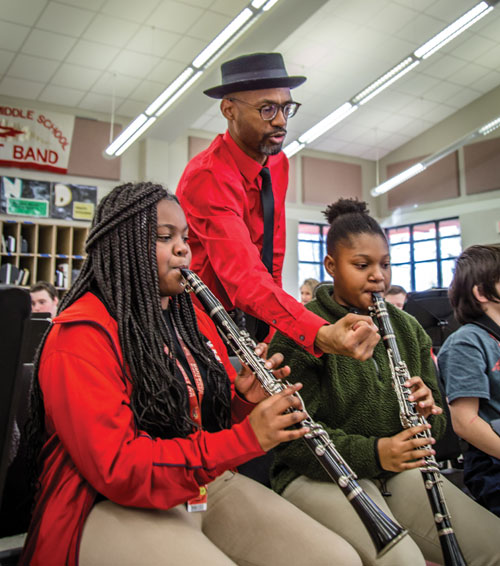
How do you show students that you love them the way they are, but also enough not to leave them that way?
Part of what is so impactful about the opportunity to teach children music is that it is more than an opportunity for them to discover the sound of their instrument. We want them to sound good, but there’s another level to it, which is the ability to discover their sound as a person. By this, I mean that every person has a unique significance and purpose. Ten-year-old children are rarely aware of what makes them unique. I have students from age 10-14, and this is a key age for self development.
I share my story with them to let them know who I am, not only as a teacher, but as a sound adult and someone they can depend on, because it is important that trust is developed.
Trust is essential to developing a relationship with your students. From trust comes relationship, from relationship comes influence, and with influence, we then are able to instruct. While we are instructing, we should not just teach the components of the instrument, but also give them key elements and principles that show them who they can be.
I find so many of my students, even those who don’t continue with music, count their time with me as an experience they will never forget. This is built on trust and comes through offering them more than a class – an experience that they can see themselves in.
At one point, you were ready to give up on teaching. What changed your mind?
It’s important to remember that individual differentiated instruction is more than just the instruction alone. Today’s educators must provide both instruction and inspiration to every student. We don’t make tubas try to sound like flutes. We try to make the two sounds fit together and complement one another. Just as we do with instruments, we should do with students. Rather than forcing children into a mold that will never fit them, take the opportunity to see who your students are and then by virtue of that, make them work together. A student taught me this.
She was struggling with some things I was unaware of, and although she was normally chipper, there were a couple days when she walked to class with her head hung low. Normally I give everybody a fist bump, tell them good morning, and welcome them to class, but when I saw her I said, “I see you.” In response, she only drooped more I can be silly, and I got down even lower, looked up at her, and said, “Hey, Miss Jones, I see you.” She smiled of a little bit and walked into class without a word.
Four years later, as happens with so many educators, I was ready to quit teaching. I couldn’t see how I was making an impact. I went home one day intending to write my letter of resignation. Waiting for me in that day’s mail was three letters from students who had been instructed by their 12th-grade English teacher to think of the most impactful, influential individual they had met during their school years and write that person a thank-you letter.
Not one of these three students continued with band, but they all thanked me and told me that what they remembered about band was who they saw themselves as when they were with me. The girl went on to share that at the time she had been feeling invisible and thinking that no one would miss her if she was gone. She carried that “I see you” all they way through the rest of her school years to battle the dark thoughts. She is the only person to whom I’ve ever said “I see you” rather than “good morning” or “hello,” and I still get chills about it, because who knows what would have happened if I hadn’t said that? This is how I learned that teaching is not just about the subject matter but about showing children that they matter. That was the last line of her letter: “Thank you for always showing us we were loved. Thank you for always showing us that we mattered.”
Last year I shared that story with a local civic group, and a woman pointed out that I had missed the most amazing part of it. She said, “When that girl was at her lowest, your words were everything that she needed to keep on going.” She said, “Little did you know, that when you’d be at your lowest, her words in that letter, would be everything that you’d need to keep on going.” She was right, because I tore up my resignation letter after reading the letter my student wrote me. I had no idea that the next year I would be a finalist for the Grammy Music Educator of the Year Award and the following year win it all and hear Alicia Keys say to me and educators across the country, “We need you. You’re loved and valued and you’re wanted.” I think if people understand their sound (significance and purpose), they will be able to teach from a better place. At the end of the day, everybody wants to know they are loved, are valued, are wanted, and that they belong. Nothing has a greater sense of belonging than ensemble whether it’s a band, choir, orchestra.
Contact Mickey Smith, Jr. through his website, mickeysmithjr.com.
